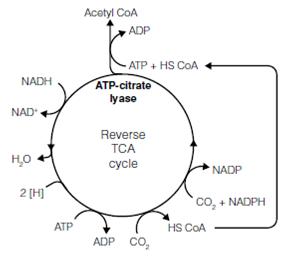Other light-independent mechanisms for fixing carbon dioxide
Some a-proteobacteria does not have the metabolic machinery to utilize some carbon compounds directly for anabolic reactions. When growing as methylotrophs the organisms cannot use C1 intermediates as a source of carbon. C1 compounds are instead oxidized completely to carbon dioxide and water, and then intracellular carbon dioxide is used directly in the Calvin cycle as a means of fixing carbon. Organisms with this ability could be called autotrophic heterotrophs. Some chemolithotrophs fall into this category too as nitrification and sulfur oxidation can be regarded as waste products of other bacteria. If both hydrogen and oxygen are present, the chemolithotroph Cupriavidus necator formerly Ralstonia eutropha uses a membrane-bound hydrogenase to chemiosmotically gener- ate ATP in Figure. A separate cytosolic hydrogenase is used to generate NADH so that both NADH and ATP can be used in a normal Calvin cycle. This aerobic oxidation of hydrogen should not be confused with the anaerobic processes used by the sulfate-reducing Bacteria.

Figure . Aerobic microbial hydrogenase pathway. H2ase, hydrogenase; Cyt c, cytochrome c; aa3, cytochrome aa3 oxidase; bc1, bc1 complex.
The problem of synthesizing carbon-containing compounds in environments rich in CO2 but poor in organic compounds has also been overcome in a different way through Chloroflexus and some Archaea. These organisms use carboxylases to convert acetyl CoA or propionyl CoA to malyl CoA and glyoxylate. The glyoxylate can then be used for anabolism while acetyl CoA is regenerated to complete the ‘hydroxypropionate cycle’ in Figure .
The concept of using what we regard as central catabolic pathways to anabolic reactions is taken to a logical extreme in the reverse citric acid cycle. The citric acid cycle normally evolves CO2 and produces reducing equivalents. However, through using much reduced compounds such as sulfide, thiosulfate or hydrogen as electron donor’s carbon can be fixed by species of Chlorobium using CO2 and water and the TCA cycle in reverse. This process requires an additional 2 ATP to yield acetyl CoA so that this molecule can act as an anabolic intermediate in Figure .

Figure . The hydroxypropionate cycle.

Figure . The reverse citric acid (TCA) cycle.